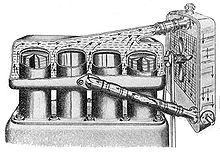Radiator Shop Near San Marcos Ca
***Same-Day*** Installation

For a FREE quote Call Now

At our Radiator shop we stock approximately 500 new radiators, including radiators, charge air coolers, and A/C condensers
Radiator Shop
If you Temperature gauge showing hot and you need radiator shop, please call us now you may need a local Radiator shop.
Looking! for a radiator repair shop? Do you see steam coming out from under the hood or water on the ground? Those may be signs that your current radiator is in need of repair.
Did you know! Repairing or replacing your radiator can save you from more costly engine repairs. At our Radiator Shop we know radiators. Whether you own a foreign or domestic car or truck, we're ready to service your radiator. We have the largest stock of new radiators in North County. Chances are if you are looking for a hard to find radiator. We carry it.
Radiators are heat ex changers used to transfer thermal energy from one medium to another for the purpose of cooling and heating. The majority of radiators are constructed to function in automobiles.
Source of Heat
The radiator is always a source of heat to its environment. This may be for either the purpose of cooling the fluid or coolant supplied to it. Despite the name, most radiators transfer the bulk of their heat via convection instead of thermal radiation.
Problems
Also, Many radiator problems begin slowly when the radiator becomes blocked with debris or rust. The radiator slowly loses its ability to cool the engine properly. You can count on Centric Auto Repair for radiator repair and replacement services that’ll keep your radiator free of debris.
Radiator fans and services include
Now, Because we specialize in radiator service, we are skilled at foreign and domestic vehicle repairs on all makes and models. We are also able to provide expert services on industrial diesel vehicles and trucks throughout the San Marcos and North County area
heat exchangers
Internal combustion engines are often cooled by circulating a liquid called engine coolant through the engine block, and cylinder head where it is heated. Then through a radiator where it loses heat to the atmosphere, and then returned to the engine. Engine coolant is usually water-based, but may also be oil. It is common to employ a water pump to force the engine coolant to circulate, and also for an axial fan[1] to force air through the radiator.
Radiator construction[edit]
Automobile radiators are constructed of a pair of metal or plastic header tanks. They are linked by a core with many narrow passageways, giving a high surface area relative to volume. This core is usually made of stacked layers of metal sheet. Then pressed to form channels and soldered or brazed together.
For many years radiators were made from brass or copper cores soldered to brass headers. Modern radiators have aluminum cores. Often save money and weight by using plastic headers with gaskets. This construction is more prone to failure and less easily repaired than traditional materials.
Coolant pump[edit]
Radiators first used downward vertical flow, driven solely by a thermosyphon effect. Coolant is heated in the engine, becomes less dense, and so rises. As the radiator cools the fluid, the coolant becomes denser and falls.
This effect is sufficient for low-power stationary engines. But inadequate for all but the earliest automobiles. All automobiles for many years have used centrifugal pumps to circulate the engine coolant because natural circulation has very low flow rates.



